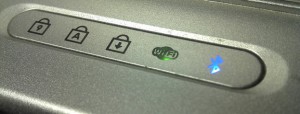Wireless networking in schools – is it safe?
May 14
 I recently did some research on the potential health effects of wireless networking in schools.
I recently did some research on the potential health effects of wireless networking in schools.
[Updates to this post follow the main text below.]
As a result of this research, I’m quite troubled by the apparently widespread use of this technology in schools. I subsequently submitted a paper to Tasmania’s Department of Education, and also to a number of politicians, in an effort to have the issues heard.
That was nearly two weeks ago, on May 2nd. I sent the submission to the IT department and the office of the Secretary, as well as Nick McKim (Education Minister), Will Hodgman (Leader of the Opposition), Jackie Petrusma (Liberal MP for Franklin), David O’Byrne (Labor MP for Franklin), and Paul Harriss (MLC for Huon). So far I’ve received no reply of any substance, just ‘read’ receipts and an assurance from Ms Petrusma’s office that she will read it with interest.
I know things move slowly in the bureaucracy and it may be some time before I hear anything about it again (if ever), but still, I’m posting it here in the hope that making the paper more easily available will generate more public interest and therefore more political pressure.
The Executive Summary of the paper is as follows (support for these points is in the document itself, below):
- A growing body of peer-reviewed scientific evidence indicates that there may be very real health risks resulting from exposure to a broad spectrum of electromagnetic radiation (EMR) frequencies (EMF), including wireless local area networks (WLAN / ‘wireless networking’ / ‘wi-fi’).
- While some peak bodies assert that there is no scientific consensus supporting suggested health concerns, the historical direction of the debate shows that the scientific consensus is slowly shifting to a position of concern as the results come in from thousands of studies.
- Reflecting this growing consensus of concern, in May 2011 the World Health Organisation (WHO) classed radio frequency (RF) electromagnetic radiation (RF-EMR, which encompasses wi-fi) as a Group 2B “possible human carcinogen”.
- As early as 1988, experts warned that children absorb high frequency EMR more readily than adults. Consequently, current radiation absorption guideline limits are breached by up to 40% in experimental models of children at maximum exposure levels that were calculated to prevent these limits being reached.
- The Australian standard developed by the Australian Radiation Protection and Nuclear Safety Agency (ARPANSA) recommends a precautionary approach which, according to ARPANSA’s fact sheet, “requires owners of RF sources to minimise unnecessary exposure of the public to RF fields”.
- Emerging international precedents are reflecting the growing concerns regarding EMR. For example, the Israeli Parliament is considering legislation that would require mobile phones to carry health warnings, and in a current case in a US civil court, a parent is suing his public school’s District due to WLAN.
- Despite the above, WLANs are becoming increasingly commonplace in schools, purely for convenience and the short-term fiscal benefits WLANs offers over wired networks. Tasmania’s Department of Education (DoE) stated that “the use of WLAN [i.e. a Group 2B possible human carcinogen] is a safe and practical solution to the computing communications needs in the modern teaching and learning environment”. DoE‘s implementation can hardly be considered to be limited to ‘necessary’ exposure – wi-fi is available 24/7, exposing children to RF EMR even when they are not using computers. This submission is a call to action to reassess current policy on the use of WLANs in schools.
One thing I touch on in the paper but don’t expand on, is the issue of permission. Despite the power of School Associations being enshrined in Tasmanian legislation and departmental policy, and despite my having chaired our School Association for a time, I’ve not been aware of a Tasmanian school that has been invited to make a decision on whether the school should use wi-fi. In our own school, the rollout of wireless networking seems to have ‘just happened’, as a fait accompli. Perhaps, if there is adequate concern, this could be one area where School Associations could flex their muscles.
The more I think about the issue, the more I get a sinking feeling. I suspect that with the growing normalisation of cancer (e.g. television viewers are currently regularly told that “one in two Australians will be diagnosed with cancer”), as a society we may just roll over and take whatever is dealt.
My submission is available, in full, here (best viewed in a non-browser-based PDF viewer to ensure diagrams are rendered correctly): Wireless Networking in Schools
Updates
- 15/5/2012 Following bodies provided with a link to the submission:
- 16/5/2012 ACCSO acknowledges receipt and thanks me for the submission.
- 16/5/2012 APC acknowledges receipt.
- 16/5/2012 The Hon Will Hodgman’s office replies. He would be interested in any response from the Hon Nick McKim. The office has also provided a copy to shadow Ministers for Education and Health. No comment on the content of the submission itself other than that it demonstrates an investment of thought and time.
- 21/5/2012 receive a receipt stating that ISCA deleted my email without reading it.
- 21/5/2012 I write to ISCA to enquire whether my email was deleted by mistake, with a copy of my submission attached.
- 25/5/2012 Read receipt received from ISCA.
- 29/5/2012 Came across this document which is a PhD thesis subtitled “an examination of the manipulation of telecommunications standards by political, military, and industrial vested interests at the expense of public health protection“, and is written by a gentleman who was involved in the standards setting process for RF radiation. And, to my surprise, he lives in Tasmania. I’m only 30 pages in to the 280 odd page thesis, but it’s very interesting reading so far.
- 30/5/2012 Contacted Federal MP Andrew Wilkie to raise concerns, following his stance on the proposed mobile phone tower at Claremont. I pointed out that, as discussed in my submission above, a report commissioned by University of Queensland demonstrated that its wireless networks account for 97% of RF radiation on its campus (i.e. far outweighing other sources such as mobile phones).
- 21/06/2012 Received an email from the Director of DoE‘s Information & Technology Services, advising that my submission has been referred to radiation experts within the Department of Health & Human Services. I expect that the response will be that since wireless devices are operating within established guidelines, their ongoing use is acceptable, but here’s hoping that a public health approach may prevail, since my issue is that the guidelines themselves are the problem.
- Italian Supreme Court rules to award Workers’ Compensation to an employee on the basis of long term mobile phone use.
See the other posts in the “Wifi” category for more updates.

I’m pretty sure everything causes cancer doesn’t it? especially worry.
There’s that sinking feeling again… Maybe the blog you’re looking for is defeatist.net? 🙂
Alana, it just goes to show how far down the rabbit hole we have gone since industrialisation. There are groups people on this earth, living the simple life, that are not afflicted with cancer, diabetes or heart disease.
Think of that when you are being bombarded with EMR from your CRT TV as they are attempting to extract money from you, with the notion that this will cure the worlds cancer problem.